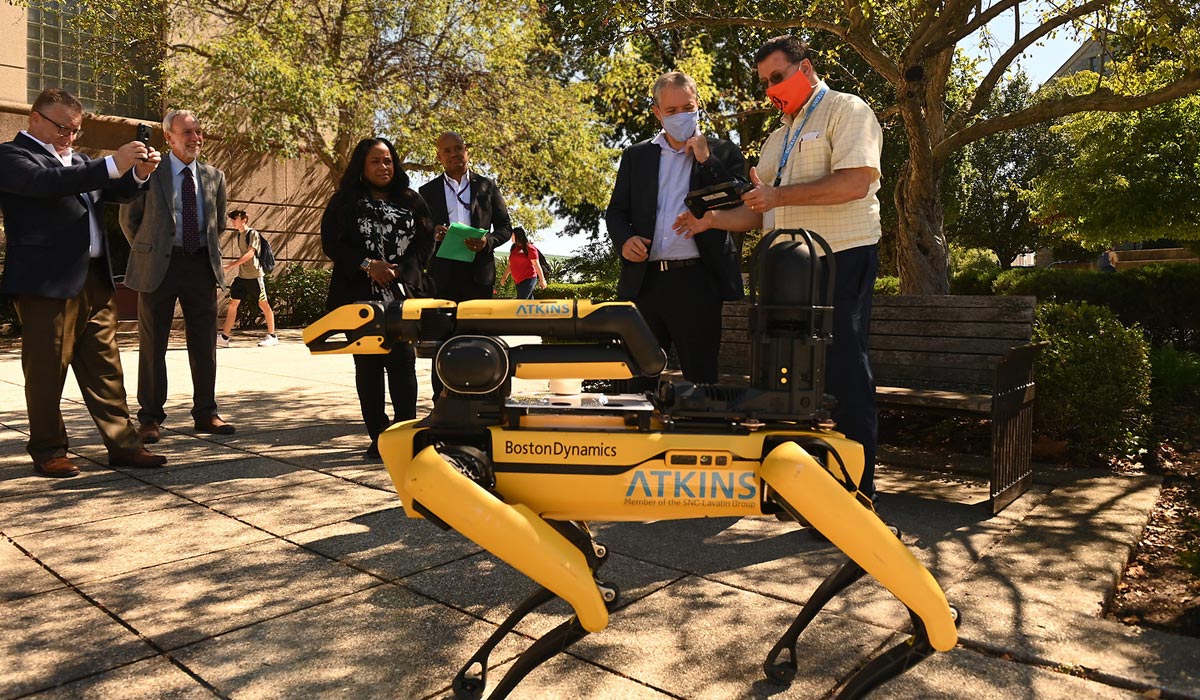

The Vitreous State Laboratory’s (VSL) long-standing partnership with the U.S. Department of Energy’s (DOE) Office of Environmental Management (EM) was on display Sept. 27 when senior leaders from the department visited campus for a tour. The group included Ike White, acting assistant secretary; Nicole Nelson-Jean, associate principal deputy assistant secretary for field operations; and Robert Crosby, chief engineer.
Established in 1968 and housed in Hannan HAll, VSL is a research and development facility focused on the study of glass and its many uses. Through a process called vitrification, VSL experts have developed methods to more efficiently transform highly radioactive nuclear waste into stable glass that can be disposed of safely. VSL provides support to various nuclear facilities in the United States, Japan, and the United Kingdom.
With an annual budget of more than $7 billion, DOE-EM operates the largest environmental cleanup program in the world. The program is focused on the safe cleanup of 107 sites across the country after decades of nuclear weapons development and nuclear energy research. This involves treatment and disposition of huge volumes of accumulated nuclear waste and decontamination and decommissioning of facilities, many of which date back to the Manhattan Project in the 1940s. Through numerous sponsored research grants, VSL conducts research and development to support that program.
Also in attendance were Jack Craig, chief operating officer, and Brad Bowan, senior vice president of engineering, technology and training of Atkins SNC Lavalin, one of the world’s most respected design, engineering, and project management consultancies. VSL has a long-term partnership with the company, working together on many nuclear waste treatment projects for DOE.
During the tour, led by VSL Director and Professor of Physics Ian Pegg, the group discussed glass formulation and melter operations enhancements related to the Hanford Tank Waste Treatment and Immobilization Plant (WTP). The WTP, the largest such facility in the world, is a DOE nuclear waste processing facility under construction in Washington state, for which VSL is providing support.
The visitors watched a demonstration of molten simulated nuclear waste glass being poured and toured VSL’s unique array of test melters. VSL is home to the largest such array in the United States, as well as the single largest test melter in the U.S., the DM1200, which is the pilot melter for the Hanford WTP high-level waste facility. The DM1200 operates at over 2000 oF and produces up to three tons of glass per day. The tour also included VSL’s state-of-the-art analytical laboratories, materials fabrication and characterization facilities, and glass leaching laboratory, where decades-long tests are running to show the resistance of different glass compositions to leaching in the environment.

The visit began outside Hannan Hall, where the group was greeted by Spot®, the quadruped robot dog, which Atkins and VSL are developing as a mobile platform for sensors, instruments, and sample collection devices to avoid exposing workers to hazards during routine inspections and maintenance of nuclear facilities.
The Office of Environmental Management posted a story about the visit to the DOE website.